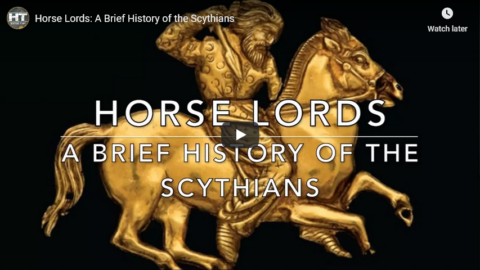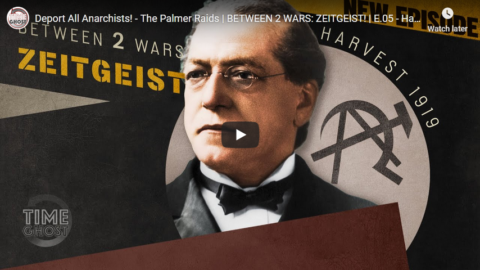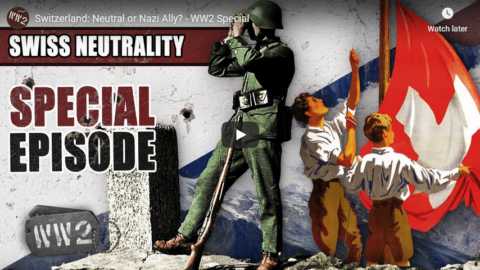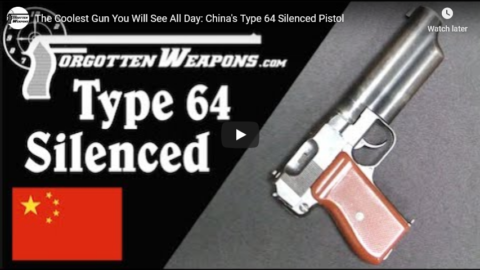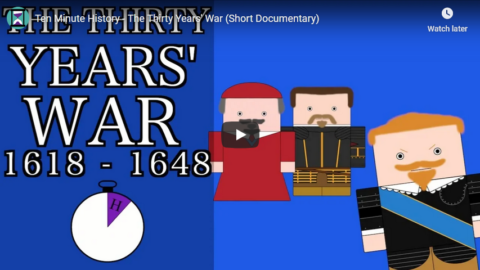History Time
Published 30 Jan 2018This video is about the Scythians. One of the first horse cultures on Earth.
Are you a budding artist, illustrator, cartographer, or music producer? Send me a message! No matter how professional you are or even if you’re just starting out, I can always use new music and images in my videos. Get in touch! I’d love to hear from you.
If you liked this video and have a spare dollar you can help support the channel here:-
http://www.patreon.com/historytimeUKI’ve compiled a reading list of my favourite history books via the Amazon influencer program. If you do choose to purchase any of these incredible sources of information then Amazon will send me a tiny fraction of the earnings (as long as you do it through the link) (this means more and better content in the future) I’ll keep adding to and updating the list as time goes on:-
https://www.amazon.com/shop/historytimeMusic used:-
Ross Bugden – “Parallel”, “Last Dawn”, “Titans”, “Olympus”I try to use copyright free images at all times. However if I have used any of your artwork or maps then please don’t hesitate to contact me and I’ll be more than happy to give the appropriate credit.
—Join the History Time community on social media:-
Instagram:-
https://www.instagram.com/historytime…
Twitter:-
https://twitter.com/HistoryTimeUK
November 27, 2020
Horse Lords: A Brief History of the Scythians
QotD: Popular music and survivorship bias
What brought this to mind was a discussion on Facebook, prompted by my quipping about music:
Man, I just {LISTENED_TO_ALBUM/WENT_TO_CONCERT} by {$GROUP_FROM_MY_TEENS/EARLY_TWENTIES} and they still kicked ass just like they did when they were new.
{$GROUP_LIKED_BY_KIDS_WHO_SHOULD_GET_OFF_MY_LAWN} just won’t have that same kind of staying power.”
Part of that phenomenon is that we’re less likely to form strong emotional connections to specific pieces of music the way we were when we were younger, and part of it is that the music that gets remembered from the good ol’ days is just the good stuff. The year 1968, for instance, had huge chart hits from The Beatles and The Rolling Stones, but also from 1910 Fruitgum Company and Tiny Tim.
The airwaves had plenty of crap in my teens and early twenties, but I prefer to forget that. Say what you will about the Kids These Days, but they aren’t listening to Milli Vanilli … of course, as it turned out, neither were kids back then.
Survivorship Bias is baked right into a lot of hobbies that interface with older things. “Man, they really knew how to build [cameras/pocket knives/watches/revolvers] in the old days!” is skewed by the fact that only the well-built stuff has survived. The handgun counter at the hardware store in a hypothetical Old West town had Colts and Smith & Wessons and Remingtons, and plenty of cheaply-made Victorian equivalents of Hi Points and Jennings, too.
Tamara Keel, “Survivorship Bias”, View From The Porch, 2020-08-24.
November 26, 2020
“… the Liberals’ oft-stated commitment to listen to the experts and the frontline workers fizzles when said experts and workers disagree with a preferred policy”
In The Line, Matt Gurney explains why the Liberals are so in love with a set of proposed rule changes that will do almost nothing to reduce gun crime in Canada and might even end up creating criminals of previously law-abiding Canadians … but it polls well in Liberal ridings:

Restricted and prohibited weapons seized by Toronto police in a 2012 operation. None of the people from whom these weapons were taken was legally allowed to possess them.
Screen capture from a CTV News report.
Talking about gun policy in Canada is tricky, because the debate is highly technical. The regulation of firearms in this country, at least in theory, depends on the specifications of the firearm in question. Mode-of-operation, magazine capacity, ammunition calibre or barrel-bore width, barrel length, muzzle energy — these are all the criteria upon which a firearm is classified into one of three categories under Canadian law: prohibited, restricted or non-restricted. Any Canadian who wishes to own or borrow a firearm, or purchase ammunition, must be licenced, a process which includes mandatory safety training and daily automatic background checks.
Prohibited firearms are essentially banned in Canada; a relatively small number are held by private citizens who already possessed them when the current regulatory regime was brought in in the 1990s. The government of the day didn’t want to get into the thorny issue of confiscation, so it let existing owners keep them under strict conditions. The vast majority of guns in Canada, and all new guns sold for decades, therefore fall into the other two categories. Restricted guns are generally pistols and revolvers, but also some rifles and shotguns. Non-restricted guns are run-of-the-mill hunting rifles and shotguns, though some sports-shooting rifles (used for target practice) are also included.
The above is all somewhat theoretical, as the regulations are twisted and pulled in a variety of ways to suit political ends, leaving a system that’s tortured and confusing even for those of us who study it. But it gives you at least an idea of how the system is designed. If you know guns, of course, you knew all this already. If you don’t, I wouldn’t blame you if your eyes glazed over a bit while reading the above. Without a basic working familiarity with all the terminology and technical specs and regulations, it’s damn hard to follow the debates over gun control. This is why I have to ask you non-aficionados to take my word for it: the Liberal proposal is really bad.
Well, actually, you don’t have to take just my word for it. You can read the NPF’s position paper, which makes at least some of the case. It notes, correctly, that “military style assault weapons” aren’t actually a thing that’s defined under Canadian law; it can therefore mean whatever the government of the day wants it to mean. True military style battle weapons — fully automatic weapons with high-capacity magazines and full-sized ammunition — are already effectively banned in Canada and have been for decades. Further, the NPF notes, firearms are used in a minority of homicides in Canada, a majority of those homicides are committed with handguns, and a majority of those killings are directly linked to organized crime or gang activity.
You’re probably starting to see the problem: Going after the guns that aren’t being used in the crimes, and taking them from the people who aren’t committing them, isn’t a public-safety policy. It’s a political gift to the Liberals’ urban base, where the proposal is popular and gun literacy low (those two latter points are not unrelated).
While the ban is almost entirely a political sop, it’s probably a good political sop, alas. I’m sure the proposal will be very well received in ridings the Liberals would like to hold or flip. But it’s still a stupid policy, even if it’s popular. The Liberals are proposing to spend tons of money on this. They estimate hundreds of millions, but recall that the long-gun registry came in about 1,500 times overbudget. And all to “ban” some of the rifles used by a segment of the population — licenced and screened gun owners — that’s been found to be the several times less likely to commit murder than those without licences.
Deport All Anarchists! – The Palmer Raids | BETWEEN 2 WARS: ZEITGEIST! | E.05 – Harvest 1919
TimeGhost History
Published 25 Nov 2020The First World War has been over for a year, and the modern era plows ahead. But so does fear and paranoia. In America, the Red Scare goes into overdrive.
Join us on Patreon: https://www.patreon.com/TimeGhostHistory
Hosted by: Indy Neidell
Written by: Indy Neidell and Francis van Berkel
Director: Astrid Deinhard
Producers: Astrid Deinhard and Spartacus Olsson
Executive Producers: Astrid Deinhard, Indy Neidell, Spartacus Olsson, Bodo Rittenauer
Creative Producer: Maria Kyhle
Post-Production Director: Wieke Kapteijns
Research by: Indy Neidell and Francis van Berkel
Image Research by: Daniel Weiss and Spartacus Olsson
Edited by: Daniel Weiss
Sound design: Marek KamińskiColorizations:
Daniel Weiss – https://www.facebook.com/TheYankeeCol…Sources:
Some images from the Library of CongressSome Soundtracks from Epidemic Sound, ODJB, Edward Elgar, Richard Strauss and Pietro Mascagni:
– “One More for the Road” – Golden Age Radio
– “Dawn Of Civilization” – Jo Wandrini
– “Deviation In Time” – Johannes Bornlof
– “Easy Target” – Rannar Sillard
– “Dark Beginning” – Johan Hynynen
– “Steps in Time” – Golden Age Radio
– “Tiger Rag” – ODJB
– “Cello Concerto” – Edward Elgar
– “Pomp and Circumstance” – Edward Elgar
– “Die Frau ohne Schatten: Act III” – Richard Strauss
– “Cavalleria Rusticana” – Pietro Mascagni
– “What Now” – Golden Age RadioArchive by Screenocean/Reuters https://www.screenocean.com.
A TimeGhost chronological documentary produced by OnLion Entertainment GmbH.
Fixing the US federal election mechanism to prevent errors or fraud from distorting the results
Down south, our American neighbours held a federal election at the beginning of November. Ignoring the Associated Press trying to annoint the winner, we still don’t legally know who won and the tallies in several states are still being challenged. This is an embarassing situation for the “leaders of the free world” and common sense changes to the way the vote is conducted seem to be the best way to ensure that the results are known quickly and that the results will fairly represent the way the voters chose to exercise their franchise. At Steyn Online, Tal Bachman has a fairly concrete set of suggestions that would be a significant improvement over the system in place today:
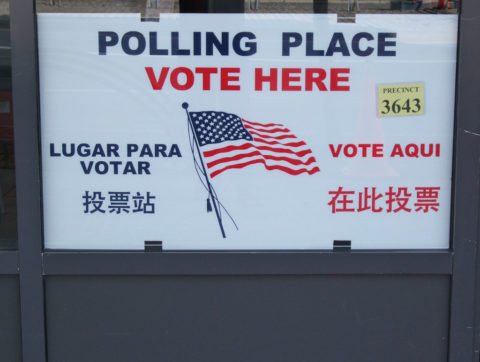
“Polling Place Vote Here” by Scott Beale is licensed under CC BY-NC-ND 2.0
First, it’s run by a single-purpose, rigorously impartial, devoutly transparent federal entity overseeing federal elections (about which more below).
Yes, I know we’re all sick of the federal Leviathan. I know it already has far too much power. It’s just that in this case, we don’t have much choice, do we? We’re going on well over a century of chronic Democrat Party presidential vote-rigging; and it appears they just ran one of their classic tricks again just a few weeks ago. At some point, pro-America voters have to stop making excuses for why they shouldn’t try solutions to these nation-destroying problems, and just try them.
Yes, I know this would require a constitutional amendment. But let’s assume for now we could get one of those passed.
Second: The new federal entity — let’s call it Elections USA — would then divide the nation into voting districts of equal size for purposes of federal election (that could occur within pre-existing congressional districts). Elections USA would then further subdivide the voting districts into smaller units. Working with the postal service, Elections USA would then draw up a list of voters in each unit, and designate a voting station for residents of that particular unit.
Third: In preparation for election day, Elections USA would send out flyers informing households of where to vote. The information would also be made available on the Elections USA website.
Fourth: On election day, voters travel to their designated voting stations: an elementary or high school, a union hall, a community center, whatever.
Each voting station is watched over by police or other security guards.
As voters approach, they join a quick-moving line. At the front, they present two pieces of government issued ID, at least one with a photo. A volunteer finds the voter on her list of voters for that unit. (If they’ve come to the wrong polling station, they are redirected to the right polling station).
The voter then approaches the voting station in a large, open room, where another volunteer hands him a paper ballot. Picking up the provided pencil, he marks the ballot behind a screen, folds the ballot, and drops into the voting box in full view of the poll clerk and attendant witnesses sitting a few feet away—typically, a few volunteers from political parties who act as “scrutineers”, or official observers and verifiers. The voter then leaves. The entire process never takes more than fifteen minutes.
Once polls close, no one is allowed to enter or leave the premises until the vote count is completed.
The poll clerk — still in full view of the scrutineers — dumps the ballots on to a table and sorts them into piles according to the candidate/party voted for. She then counts the votes for each, showing them to the scrutineers as she goes. Once the votes are counted, a supervisor is called over to the table. After verifying that the scrutineers are satisfied with the counting, and resolving any lingering concerns, the supervisor signs off on the count, and the ballots are immediately placed in a special, sealed envelope. The sealed envelope is then stamped, and cannot be opened without subsequent detection.
The ballot count numbers are then phoned into Elections USA, right then and there, again in view of the scrutineers, who verify that the numbers called in match the numbers they witnessed during the count.
Once all the numbers are called in to Elections USA — a process which never takes more than two hours — the supervisor then physically transports the sealed envelopes (each marked with information like Voting Desk #4 at Poll Station #15) to the Elections USA depot, where she hands them over.
“2019 Canadian federal election – VOTE” by Indrid__Cold is licensed under CC BY-SA 2.0
The sealed envelopes are then transported to Elections USA employees, who will then verify, and eventually formally certify, that all the numbers called in from each desk of each polling station of each voting district in the country matches the number of actual ballots. In the unlikely event any question arises about accuracy, the ballots can be accessed and counted again.
In a simple process like this, the media will have accurate election results within two hours of the polls closing, and there is virtually no opportunity for fraud. I can attest to that, because I myself have witnessed this exact process in real life quite a few times, and am friendly with several people who volunteer as election workers on election days. What I described is how elections are conducted in Canada, but not only in Canada: an identical or similar process is used in most other English-speaking countries. A few simple security protocols — not least of which is, no computerized voting machines — and your election is as fraud-proof as this mortal realm would ever allow.
When you compare this typical voting procedure to the morass of conflicting voting regulations representing fifty states, many of which — incredibly — do not even require that the voter present identification before voting, and which are being manipulated by the very state party hacks tasked with preventing fraud, you begin to see just how desperately America needs electoral reform. Credible stories of poll watchers being denied access, for example, in any normal country, would be regarded as completely unacceptable, to the point where the votes in that area would be likely thrown out as a matter of course. And yet, that type of chicanery is now so common in the United States, most people take for granted it goes on. That’s how far the window of acceptable behavior has moved.
Tank Chats #86 | Coventry Armoured Car | The Tank Museum
The Tank Museum
Published 18 Oct 2019David Fletcher looks at the British WW2 Coventry Armoured Car. It never saw service and was already considered obsolete by the time it was built.
Support the work of The Tank Museum on Patreon: ► https://www.patreon.com/tankmuseum
Visit The Tank Museum SHOP: ► https://tankmuseumshop.org/
Twitter: ► https://twitter.com/TankMuseum
Instagram: ► https://www.instagram.com/tankmuseum/
Tiger Tank Blog: ► http://blog.tiger-tank.com/
Tank 100 First World War Centenary Blog: ► http://tank100.com/
#tankmuseum #tanks
QotD: The “history-as-nightmare” narrative
The idea of the past as nothing but a nightmare, specifically one of injustice, is probably the prevailing historiographical trope of our time. Certainly no one could reasonably claim that nightmares have been lacking in human history. And yet, at the same time, it is undeniable that there has been progress: very few of us would care to take our chances in the kind of conditions, either political or material, that prevailed in, say, the 16th century.
The fact remains, however, that for more than one reason, history-as-nightmare is nowadays an infinitely more powerful organising narrative principle than history-as-progress.
In the first place, nightmares present themselves much more vividly to the imagination than the slow accretion of progress, just as hell is much more easily envisaged than heaven — and more enjoyable to imagine, too.
In the second place, when progress occurs, it is immediately taken for granted, as if it were a merely natural process that had never really required human effort to take place. Who now is grateful for the elimination of the suffering caused by peptic ulceration, for example? There is simply no cultural recollection of peptic ulceration at all, though well within living memory books were written about how to live with, or despite, your ulcer, what diet to take to assuage your ulcer, and so forth. Once they are cured, it is simply taken for granted that people do not have such maladies — progress magically did away with them.
In the third place, and most importantly, the fact of progress is much less useful to political entrepreneurs than is the narrative of history as nothing but a nightmare that continues to the present day and, as Marx put it, weighs upon the brain of the living. Only by keeping the memory of the nightmare ever-present in the minds of their sheep, thereby stoking resentment, may the political shepherds herd, and then fleece, the flock.
A fourth great advantage of history-as-nightmare is that it explains the failures and failings of everybody who is dissatisfied or disappointed with his life. To misquote Shakespeare: The fault, dear Brutus, is not in ourselves, but in our stars, that we are underlings. We do not fail the world, the world fails us. How comforting a thought!
Theodore Dalrymple, “Against History-as-Nightmare”, Law & Liberty, 2020-08-11.
November 25, 2020
Switzerland: Neutral or Nazi Ally? – WW2 Special
World War Two
Published 24 Nov 2020After the fall of France in June 1940, neutral Switzerland found itself surrounded on all sides by a hostile expansionist power. The small nation would have been a valuable possession but the jaws of the Reich hesitated to swallow it. How did Switzerland manage to exit the conflict intact and largely unscathed?
Join us on Patreon: https://www.patreon.com/TimeGhostHistory
Or join The TimeGhost Army directly at: https://timeghost.tvFollow WW2 day by day on Instagram @ww2_day_by_day – https://www.instagram.com/ww2_day_by_day
Between 2 Wars: https://www.youtube.com/playlist?list…
Source list: http://bit.ly/WW2sourcesHosted by: Spartacus Olsson
Written by: Lennart Visser & Francis van Berkel,
Director: Astrid Deinhard
Producers: Astrid Deinhard and Spartacus Olsson
Executive Producers: Astrid Deinhard, Indy Neidell, Spartacus Olsson, Bodo Rittenauer
Creative Producer: Maria Kyhle
Post-Production Director: Wieke Kapteijns
Research by: Lennart Visser
Edited by: Karolina Dołęga
Sound design: Marek Kamiński
Map animations: Eastory (https://www.youtube.com/c/eastory)Colorizations by:
Adrien Fillon – https://www.instagram.com/adrien.colo…
Cassowary ColorizationsSources:
– Pictures of Swiss Army by Strübin Theodor courtesy of Archäologie und Museum Baselland Lizenzbedingungen
– Bundesarchiv
– Imperial War Museums: HU56131
– ETH-Bibliothek Zürich: 03258, LBS MH05-02-04, M01-0756-0001
– Fortepan:3889, 92301
– National Archives
– Staatsarchiv Bern – P362
– Plan of the defence lines of the National Redoubt courtesy of Auge=mit from Wikimedia Commons
– Picture of Swiss Soldiers with anti-aircraft gun courtesy of Paebi from Wikimedia Commons
– Picture of Swiss aircraft in 1943 from theM.Pilloud – Archive familiale
– United States Holocaust Memorial MuseumSoundtracks from Epidemic Sound:
– “Other Sides of Glory” – Fabien Tell
– “Moving to Disturbia” – Experia
– “Remembrance” – Fabien TellArchive by Screenocean/Reuters https://www.screenocean.com.
A TimeGhost chronological documentary produced by OnLion Entertainment GmbH.
From the comments:
World War Two
1 hour ago
As we draw close to the end of 1941, it becomes clear that neutrality is not a guarantee of safety. Its utility as a diplomatic strategy has been discarded and is non-existent.A total of 12 sovereign and neutral nations have been invaded by Allied or Axis powers since the beginning of the war — Denmark and Norway on 9 April 1940; Belgium, the Netherlands, Iceland and Luxembourg on 10 May 1940; Lithuania on 15 June 1940 and Latvia and Estonia on 17 June; Greece on 28 October 1940 and Yugoslavia in April 1941; Iran in August 1941. Even those that are spared are compelled to assist either the Allies or the Axis or both in financial and economic terms, such as Switzerland and Sweden. Others offer voluntary military assistance such as Portugal and Spain.
Jan Morris, RIP
By an odd co-incidence, I began reading the third volume of Morris’s British Empire trilogy just last night and today I discovered that she recently died at age 94. The particular edition I have has Morris’s original male name on the cover, but her female name in the “note about the author”:
Jan Morris, who died last week at the age of 94, may have lived one of the more various and accomplished lives on record. She was, in turn, a soldier, a newspaper correspondent with a number of scoops to her name, a fine memoirist, and a writer of books whose scope encompassed the world.
Any dutiful obituarist must also note something else which happened fifty years ago. It is likely for ever to feature in the first paragraph, if not the first line, of everything written about Morris. She was born a man, named James by her parents, and underwent what her publishers and profilers term “a change of sexual role” in 1972 – back when such a thing was a rarity and rather dangerous to accomplish.
I hope to leave that subject aside for a moment while contemplating her place in letters. By the end of her long life, Morris had become something of a national treasure and an institution. Her quixotic obsessions – a personal, mythical interpretation of the Welsh side of her family and her home in that country, and the late First Sea Lord Jackie Fisher – became the subject of stories shared by friends, editors and admirers.
She gave wise and funny interviews to the papers about savouring mussels without dignity and why whether what one is doing is kind ought, in a good world, to be the modest test applied to action.
Other profilers note her long companionship with Elizabeth (née Tuckniss) – first through marriage, then a legally-divorced close friendship, and finally a civil partnership, with the ceremony witnessed by a local couple who afterwards invited the two for tea. Elizabeth survives Jan, but a visiting journalist or two was shown the headstone which is planned for both of them. They will lie on a Welsh island they owned in the Dwyfor, a river that runs by their home. The stone reads: “Here lie two friends, at the end of one life”.
These are beautiful stories, but they should not retroactively colour in fully our impressions of Morris. Nor should a sense – repeated in some otherwise careful obituaries – that as “James”, Morris’s “written voice always sounded certain”. Whereas as Jan, her writing grew more introspective and aware of the ways that time and tide conspire to decay the facades of men as much as they do institutions and places. This was exhibited notably in her Pax Britannica trilogy, which chronicled Britain’s imperial decline.
The Coolest Gun You Will See All Day: China’s Type 64 Silenced Pistol
Forgotten Weapons
Published 14 Aug 2020http://www.patreon.com/ForgottenWeapons
https://www.floatplane.com/channel/Fo…
Cool Forgotten Weapons merch! http://shop.bbtv.com/collections/forg…
The Type 64 is a dedicated suppressed pistol first introduced in 1965 and used in the Vietnam War. It uses a rimless version of the .32 ACP cartridge (7.65x17mm) in a 9-round Makarov-like magazine. Despite outward similarity to the Makarov (especially the grip), the design is wholly unique internally. It uses basically a miniaturized AK bolt to allow the shooter to select between blowback semiauto functioning and single shot manual operation. The bolt’s rotating locking lugs prevent it from cycling when locked, in a very clever alternative use of the rotating bolt system. The suppressor has two chambers, using a combination of baffles and wire mesh as suppressor elements. In addition to standard ammunition, a plastic-sabot frangible load was also developed for use in situations like airline hijackings, and this loading is why some sources reference a maximum effective range of 15 meters.
For all its technical cleverness, the Type 64 is a rather heavy pistol, at 1.8kg / 4 pounds. It was replaced in 1967 by the substantially lighter and simpler Type 67, which weighed only 1.05kg / 2.3 pounds. This particular Type 64 was originally owned by Mitch Werbell III, giving it an even more interesting history …
Contact:
Forgotten Weapons
6281 N. Oracle #36270
Tucson, AZ 85740
QotD: Tonnage measurement(s)
The easiest tonnage to understand is displacement tonnage. This is the actual weight of the ship, called displacement because the weight of the ship is equal to the amount of water it displaces, per Archimedes’ principle. Of course, the displacement of a ship can change greatly depending on what’s aboard, so several different displacements are often used. A good reference will give three values, light, normal, and full. Light is basically an empty ship. There are some technical details, but in essence it’s what the ship weighs if we take all the people, fuel, cargo, ammunition, and supplies out of it. Full displacement is exactly what you’d expect from the name. The ship is as heavy as it’s ever going to be, with full fuel, ammo, and cargo. Normal is essentially a ship with full cargo and crew, but two-thirds fuel and ammunition. On warships, it’s common for light displacement to be 75% or so of full displacement, so it’s obvious that a poor choice of reference numbers can cause confusion about the actual sizes of the ships in question. Displacement tonnage in non-metric references is always given in long tons of 2,240 lb each. This is to allow easy conversion, as a long ton of salt water has a volume of almost exactly 35 cubic feet.
Displacement tonnage is the only tonnage value commonly used for warships, while merchant ships use a completely different set of tonnages, usually deadweight tons, gross tons, and net tons. Deadweight tonnage is at least an actual measure of weight, and specifies how much cargo the ship is able to carry, excluding the weight of the ship itself. Gross tonnage and net tonnage are both basically volumetric measures, specified using complicated formulas. Gross tonnage is based on the total volume of all enclosed spaces of the ship, while net tonnage is based only on the volume of the spaces that carry cargo or passengers. These values are used to calculate things like port duties and what regulations apply to the ship. They replaced gross and net register tons, which were also volumetric, of 100 cubic feet to the ton. These were based on a phenomenally complicated set of rules to determine what spaces were and weren’t counted, with shipowners trying to game the system and drive down their tonnage. Worse, different countries had different regulations on what counted under each value, so in 1969, register tonnages were abolished and replaced with the existing system.
While distance, speed, and “tonnage” measurements are the most prominent nautical idiosyncracies, there are a few other values that bear mentioning. The maximum width of a ship is the beam, apparently from the beams that used to run across ships during the days of sail. Draft (or draught) is how deep the hull is below the waterline. This is a very important number to make sure the ship doesn’t run aground, but it varies continually with the amount of stuff on the ship. Air draft is sometimes used for height above the water, important for clearing bridges and the like. Length, much like tonnage, comes in several values. The obvious one is length over all, LOA, which is exactly what it sounds like, measured from the furthest forward to the furthest aft point on the ship. This is obviously useful, but for hydrodynamic purposes another value, waterline length (LWL), is what the designer cares about. The last value is length between perpendiculars (LBP), measured between the vertical stem (bow) post and the vertical stern post. This is another value that was developed for civilian use. Some ships of a given LOA have a great deal of overhang at bow and stern, making them much smaller than other ships with the same nominal LOA. Using LWL is not a good solution, as it varies with draft. LBP solves both of these problems, but isn’t of great importance to warships.
Bean, “Nautical Measurements”, Naval Gazing, 2018-08-10.
November 24, 2020
The History of Fabric Is the History of Civilization
ReasonTV
Published 23 Nov 2020Virginia Postrel’s new book explores economics, politics, and technology through textiles.
——————
Full text and links: https://reason.com/video/2020/11/23/t…Follow us on Twitter: https://twitter.com/reason
Reason is the planet’s leading source of news, politics, and culture from a libertarian perspective. Go to reason.com for a point of view you won’t get from legacy media and old left-right opinion magazines.
—————-The Fabric of Civilization: How Textiles Made the World, a new book by former Reason editor in chief Virginia Postrel, is a rich, endlessly fascinating history of the remarkable luck, invention, and innovation that made our fabric-rich world possible.
The book aims to make the mundane miraculous. Consider cotton. Most of the cotton we grow today is descended in part from a plant species that evolved in Africa and somehow got over to what is now Peru, where it mixed with New World strains.
“The fact that we have cotton at all, that it exists anywhere, is amazing,” says Postrel. “It happened long before there were human beings, but much more recently than when the continents were together. So we don’t know. It could have gotten caught up in a hurricane. It could have floated on a piece of pumice. So it’s this random, very unlikely happening that had tremendous world-changing consequences.”
The story of textiles is rife with attempts at protectionism and prohibition. In 17th and 18th century Europe, countries banned the importation of super-soft, super-colorful cotton prints from India known as calicos because they threatened domestic producers of everything from lower-quality cotton fabric to luxury silks. “For 73 years, France treated calico the way the U.S. treats cocaine,” Postrel says. “There was this huge amount of smuggling, and they were constantly ratcheting up the penalties [so] that they got quite grotesque, at least for the major traffic.” Some of “the earliest writings of classical liberalism are in this context, people saying not only is this not working, but … it is unjust to be sentencing people to the galleys in order to protect silk makers’ profits.”
Postrel also documents how the Luddites, the 19th century English textile workers famous for smashing the power looms threatening to put them out of work, owed their jobs to an earlier technological breakthrough: the spinning machines that emerged in the late 1700s.
“If you go back to that earlier period, when spinning machines were introduced, the same thing happened,” she says. “They had their own period of rebelling against the new technologies and saying they’re putting people out of work.”
The book also upends some contemporary myths, such as the claim that commercial production of hemp for clothing was a casualty of the war on drugs. “Hemp historically was a very coarse kind of fabric for poor people who didn’t have an alternative,” says Postrel. “It was replaced by cotton for good reasons. Cotton was also affordable, but it was soft and washable and just a much better fabric.”
“Human beings live in history and we inherit the legacies, positive and negative, of that history,” says Postrel, whose previous books include The Power of Glamour, The Substance of Style, and The Future and Its Enemies. Discussing the large themes of her work she says, “All you can do is start from where you are and try to do better from where you are.”
Narrated by Nick Gillespie. Edited by Isaac Reese.
Music: “Thoughts,” by ANBR
Photos: World History Archive/Newscom; The Print Collector Heritage Images/Newsroom; The “Réale” returning to port, Med/CC BY-SA 3.0; Smithsonian National Museum of African American History and Culture/CC0; Battle of Grand Port, Rama/Wikimedia Commons/CC BY-SA 2.0 FR; Fine Art Images Heritage Images/Newscom; Seton, M., Müller, R., Zahirovic, S., Gaina, C., Torsvik, T., Shephard, G., Talsma, A., Gurnis, M., Turner, M., Maus, S., and Chandler, M., 2012, Global continental and ocean basin reconstructions since 200 Ma: Earth-Science Reviews, v. 113, no. 3-4, p. 212-270
Is the day of the orator over?
In The Critic, Nigel Jones considers some of the great orators of history:
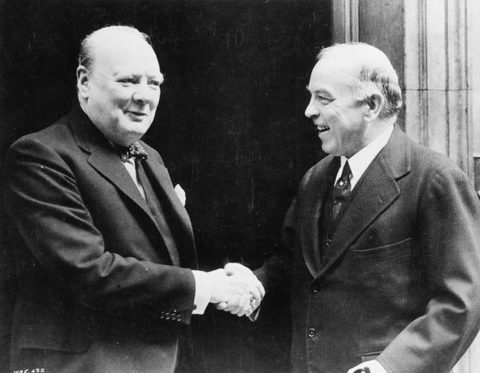
Prime Minister Winston Churchill greets Canadian PM William Lyon Mackenzie King, 1941. Churchill was certainly one of the great orators of history … Mackenzie King, on the other hand, certainly was not.
Photo from Library and Archives Canada (reference number C-047565) via Wikimedia Commons.
On 19 November 1863, President Abraham Lincoln rose to speak at Gettysburg, Pennsylvania, the battlefield which four and a half months before had seen the decisive turning point of the American Civil War. Lincoln was not even the principal speaker at the ceremony to dedicate a cemetery for those who had fallen in the battle.
Before he spoke, the President had to sit through a two-hour address by a pompous official orator, a windbag called Edward Everett. But when he finally got to his feet Lincoln entered political immortality. He spoke for only two minutes, but the few words he uttered about “Government of the people, by the people, and for the people” have echoed down the years – even Mrs Thatcher made a recording of them – inspiring and rousing generations to value and defend democracy.
Winston Churchill’s iconic status as Britain’s greatest Prime Minister largely rests on the handful of radio speeches he growled out to the nation in the darkest days of World War Two: “… fight them on the beaches … so much owed by so many to so few … this was their finest hour …” and so on.
Ever since Roman statesmen such as Cato and Cicero delivered their speeches on the Capitol, oratory like that spoken by Lincoln and Churchill has been a mainstay of western civilisation and governance. A carefully constructed argument or a few ringing phrases having the power to change minds, stiffen sinews, and bring down leaders.
Churchill himself was brought to supreme political power in 1940 by the power of the spoken word. Those words were spoken by one politician – his friend and schoolmate Leo Amery – quoting another, when Amery repeated Oliver Cromwell’s words dismissing the Long Parliament in calling for the end of Neville Chamberlain’s feeble administration: “You have sat here too long for any good you have been doing. Depart, I say, and let us have done with you: in the name of God, go!” Chamberlain, albeit reluctantly, went.
Ten Minute History – The Thirty Years’ War
History Matters
Published 30 Sep 2018Twitter: https://twitter.com/Tenminhistory
Patreon: https://www.patreon.com/user?u=4973164Special Thanks to the following Patrons for their support on Patreon:
Chris Fatta
Joshua
Mitchell Wildoer
Mason Cox
William Foster
Thomas Mitchell
Perry Gagne
Shaun Pullin
Anon
Spencer Smith
Matt M
RbjThis episode of Ten Minute History (like a documentary, only shorter) covers the outbreak of the Bohemian Revolt which was what would eventually spiral out of control into the Thirty Years’ War. The revolt was crushed fairly quickly but sparked intervention by Denmark, who didn’t do too well, and later Sweden who did very well. Both of these were aided by France who decided to get directly involved in 1635. By 1648 the Holy Roman Empire lay in ruins, with Austria and Spain struggling to pay for the war and rebuild the Habsburg Empire. This war saw the rise of Sweden and France but most importantly saw the foundations of modern diplomacy built.
Recommended books:
Mark Greengrass – Christendom Destroyed: Europe 1517-1648. Does a great job of outlying the theological currents in Europe at the time and how all of the religious changes led to the Thirty Years’ War.
Peter H. Wilson – Europe’s Tragedy: A New History of the Thirty Years’ War. The go-to text for the war; incredibly detailed and honestly can’t be beat for the topic. 100% recommend.
QotD: Canada’s economic Stockholm Syndrome
Trade agreements are always about “concessions” in which foreign suppliers are grudgingly given — or, more often, indignantly denied — the right to sell Canadians goods and services at prices lower than what we pay now. Let’s be clear here: lowering the price of consumer goods and services has the exact same effect on household welfare as an increase in incomes. But I defy you to name an elected politician who will list “the ability to buy cheaper stuff” as the most compelling reason to support free trade: more than 200 years since Adam Smith wrote that paragraph, our trade agenda is still written by and for producer interests.
We’re stuck with a system in which producer interests — most notoriously the dairy cartel that operates under the name of “supply management” — hold the rest of us hostage. Dismantling the dairy cartel is an act that would significantly increase consumers’ buying power, but this is a measure that the Conservatives have all but ruled out under any circumstances, and the NDP has made maintaining the cartel a condition for supporting any sort of trade agreement.
Why would the [major parties] stubbornly insist on sticking to a policy that makes consumers worse off at the expense of producers? Because it’s a popular position. It’s one of the marvels of the Canadian electorate. Show Canadians a special interest group that uses its government-granted privileges to fleece consumers, and they’ll embrace it as a “national champion,” a “uniquely Canadian way of life” or some equally vapid catch-phrase.
This is from the Wikipedia entry for Stockholm Syndrome:
Stockholm syndrome, or capture–bonding, is a psychological phenomenon in which hostages express empathy and sympathy and have positive feelings toward their captors, sometimes to the point of defending them.
What we suffer from is the economic policy equivalent. Call it “Canada Syndrome”: a tendency for consumers to identify with the producer interests that are holding them hostage.
Stephen Gordon, “Our Stockholm Syndrome about supply management”, Maclean’s, 2013-03-05.

